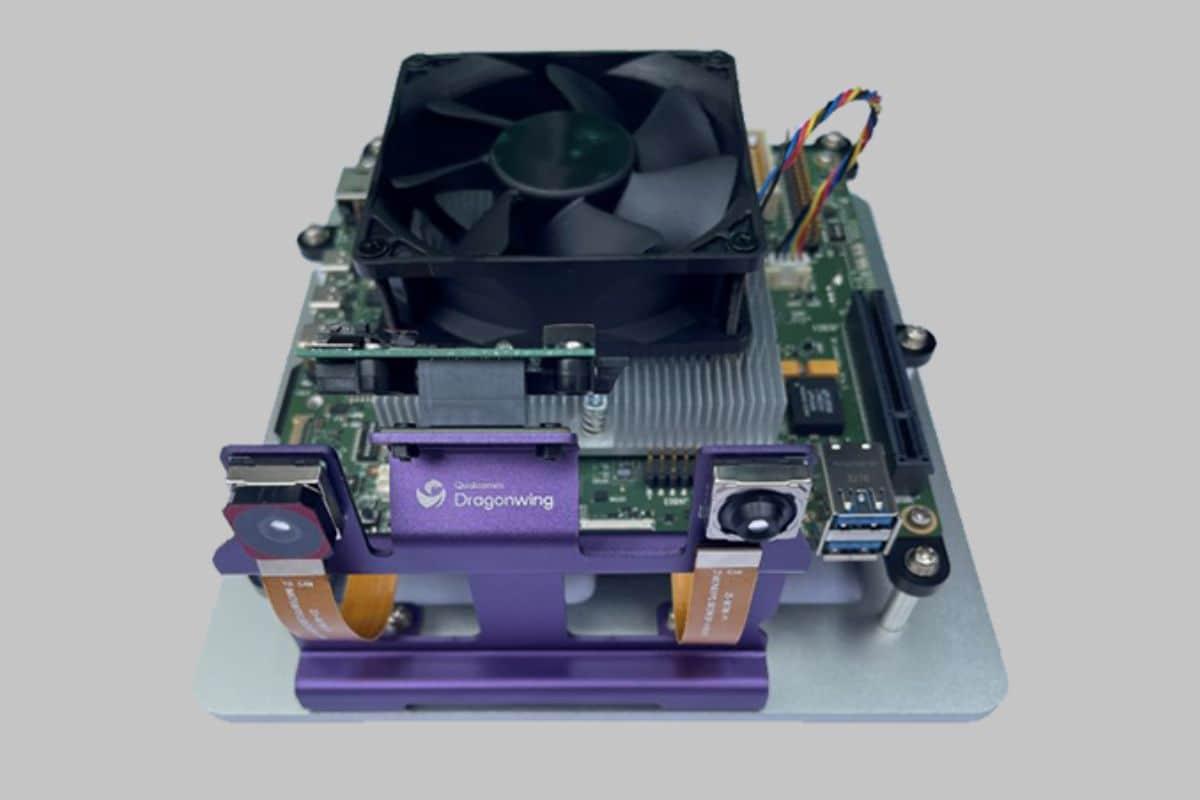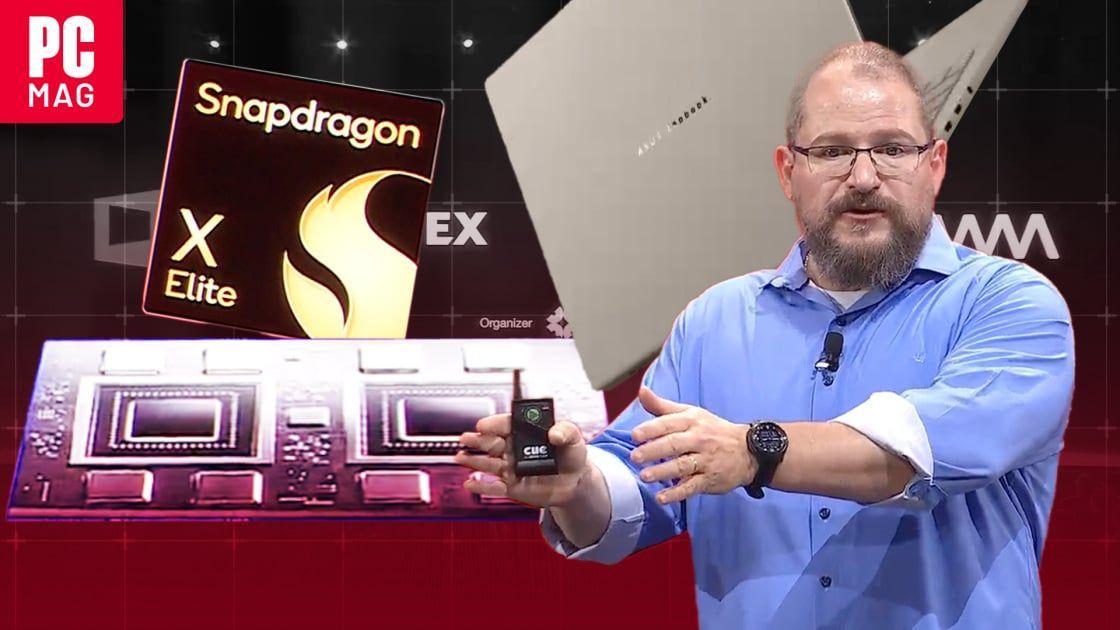Qualcomm Enters Industrial Computing with AI-Powered Dragonwing IQ-X Series Chipsets
4 Sources
4 Sources
[1]
Qualcomm Unveils Dragonwing IQ-X Series Industrial Chipsets
Commercial devices featuring the chip will arrive in the coming months Qualcomm, on Friday, unveiled its Dragonwing IQ-X series of chipsets, which are designed for industrial use cases. The processors will power programmable logic controllers (PLCs), advanced human-machine interfaces (HMIs), edge controllers, panel PCs and box PCs. These platforms are designed by the company to function during harsh operating conditions with a ruggedised package. Additionally, the chipmaker states that it has added peripheral support to enable easy integration across a wide range of industrial equipment. The key focus areas of the chipset are multimedia capabilities, support for AI workloads, and a power-efficient design, Qualcomm said. Qualcomm's Dragonwing IQ-X Series Chipsets to Power Smart Industries In a press release, the San Diego-based semiconductor giant detailed the upcoming Dragonwing IQ-X series chipsets. It is powered by a custom-designed Oryon CPU architecture, which is built on a 4nm process technology. It has a configuration of eight to 12 high-performance cores reaching up to 3.4GHz clock speeds. The series supports up to 45 TOPS (tera-operations per second) of AI-performance via its integrated NPU (Neural Processing Unit), aimed at enabling edge-AI workloads such as defect detection and predictive maintenance. The IQ-X series supports a temperature range from -40 degrees Celsius to 105 degrees Celsius, targeting deployment in hostile environments, such as industrial automation, robotics and energy control systems. Peripheral support includes up to 64GB LPDDR5x memory, UFS 4.0 storage, multiple display and camera interfaces and extensive I/O (including up to 221 GPIOs). On the software side, the platform integrates with Windows 11 IoT Enterprise long-term servicing channel (LTSC) along with industrial middleware and frameworks such as Qt, CODESYS and EtherCAT. The processors are offered in Computer-on-Module (CoM) form factors to ease integration into existing carrier boards and reduce bill-of-materials for original equipment manufacturers (OEMs). Key technical details of the series include: support for high-speed storage (UFS 4.0), multiple camera sensors (up to six on the higher-end variant), PCIe Gen4 connectivity, display outputs up to 5120 x 2880p at 60Hz refresh rate, and extensive support for Ethernet, Wi-Fi 7 and 5G cellular networking modules. The company states the IQ-X series is engineered to enable OEMs and ODMs to build and deploy ruggedised, high-performance edge computing devices more quickly and at lower complexity. Qualcomm says companies such as Advantech, congatec, NEXCOM, Portwell, Inc., SECO and Tria are among the early adopters designing products around the IQ-X series.
[2]
Qualcomm To Bring Custom CPU Used For Snapdragon X Chips To Industrial PCs
The move stems from Qualcomm's $1.4 billion acquisition of chip design startup Nuvia in 2021, a deal that has supported ongoing efforts to diversify its business beyond mobile chipsets by giving it powerful custom CPU designs based on the Arm instruction set architecture. Qualcomm announced Thursday that it's bringing the custom, Arm-compatible CPU used for its Snapdragon X Series chips to a new lineup of processors for industrial PCs. Set to debut in industrial PCs in the coming months, the new Dragonwing IQ-X Series packs Qualcomm's Oryon CPU along with a GPU and NPU inside a "ruggedized" system-on-chip package that can withstand extreme temperatures from -40 degrees to 221 degrees Fahrenheit, according to the San Diego-based company. [Related: Jury Sides With Qualcomm Over Arm In Case Related To Snapdragon X PC Chips] The move stems from Qualcomm's $1.4 billion acquisition of chip design startup Nuvia in 2021. The deal has supported the company's ongoing efforts to diversify its business beyond mobile chipsets by giving it powerful custom CPU designs based on the Arm instruction set architecture. The company has been executing on its plan to integrate these custom CPU designs into products across different segment lines, starting last year with the Snapdragon X Series chips for Windows PCs. Qualcomm said these are the "first industrial-grade PC processors engineered to accelerate smart manufacturing across devices," including box PCs, panel PCs, edge controllers, advanced human-machine interfaces and programmable logic controllers. OEMs set to release devices with the Dragonwing IQ-X Series include Advantech, Congatec, Kontron, Nexcom, Portwell, Tria Technologies and SECO. In a briefing with journalists, Anand Venkatesan, senior director of product management at Qualcomm, said the Dragonwing IQ-X series is a "single, monolithic platform" designed to eliminate the need for partners and customers to make "very difficult tradeoffs" in systems. "Either it is speed in terms of single-thread performance or power savings or it is I/O flexibility, which is a tradeoff for lower cost," he said earlier in the week. Marking the first Dragonwing IQ chips with a custom CPU design, the processors scale from eight to 12 cores, with the maximum frequency on a single thread reaching 3.4GHz, offering what the company called "best-in-class" single- and multi-threaded performance. The NPU will offer 45 trillion operations per second across the lineup. With support for the Windows 11 IoT Enterprise LTSC operating system, the processors support a "range of industry-leading software, middleware and applications," including Qt Codesys, Ethercat and "other powerful tools," Qualcomm said. The company is pushing the NPU as a way to accelerate AI workloads for industrial solutions, saying that developers can do so using the Qualcomm AI Software Stack as well as common runtimes like ONNX and PyTorch. The Dragonwing IQ-X Series is designed to support industry-standard COM module form factors for "drop-in replacement on existing carrier boards" as well "standard hardware peripherals and bridge chips used in the industry," according to the company. Qualcomm said the Dragonwing IQ-X Series can reduce the bill of materials for partners and customers building systems by eliminating the need for external AI accelerators or multimedia modules due to the integration of such features within the chips. Venkatesan told CRN that the processors will be supported by the Qualcomm Partner Network program, calling systems integrators a significant part of the company's go-to-market efforts. "They'll play a very key role in [pushing] adoption. In fact, most of the problems of today that require edge intelligence to improve the productivity of a particular customer or a use case [are] actually coming to us from the systems integrators," he said.
[3]
Qualcomm Dragonwing IQ-X Series industrial processors with multimedia and AI capabilities announced
Qualcomm Technologies has announced the Dragonwing IQ-X Series, a new lineup of industrial-grade processors designed for PLCs, advanced HMIs, edge controllers, panel PCs, and box PCs. Engineered for demanding environments, the series supports a wide range of industrial equipment through extensive peripheral compatibility and offers multimedia capabilities in an energy-efficient design. The Dragonwing IQ-X Series is developed to meet the requirements of industrial OEMs and ODMs, providing: The series supports standard COM module form-factors, allowing direct replacement on existing carrier boards. An evaluation kit provides scalable solutions across industrial segments. It is compatible with standard hardware peripherals and bridge chips, and supports software, middleware, and applications on Windows 11 IoT Enterprise LTSC, including Qt, CODESYS, and EtherCAT. The integrated NPU, together with the Qualcomm® AI Software Stack and runtimes such as ONNX and PyTorch, enables industrial AI applications like predictive maintenance, condition-based monitoring, and defect detection. This simplifies AI model deployment and supports development for intelligent edge systems. Leading OEMs including Advantech, congatec, NEXCOM, Portwell, SECO, and Tria have adopted the Dragonwing IQ-X Series platform. Commercial devices are expected to become available in the coming months. Speaking on the launch, Nakul Duggal, Group General Manager, Automotive and Industrial & Embedded IoT, Qualcomm Technologies, Inc., said:
[4]
Qualcomm's new chip for smart factories: Dragonwing IQ-X details explained
Smart factories gain edge AI, rugged performance, and decades-long support If you've followed Qualcomm over the years primarily for their Snapdragon chips - the ones inside your phone, your laptop, maybe even your XR headset - you're forgiven for wondering why the company suddenly wants to talk about programmable logic controllers, panel PCs, and "ruggedized enclosures that survive 105°C." I had the same reaction when I sat through the briefing of the new Qualcomm Dragonwing IQ-X Series, an industrial-grade processor family aimed at smart factories and edge controllers. It's a world where phrases like IP65, fanless chassis, and predictive maintenance get executives excited. Not exactly the stuff that usually gets headline treatment. But it's worth paying attention to, because what Qualcomm's doing here is essentially exporting two decades worth of mobile-compute innovation into one of the last big frontiers still running on legacy silicon. Best way to contextualise this is to think of factories as the world's slowest smartphones which are finally getting a much-needed upgrade. For years, Qualcomm's biggest story has been performance-per-watt, about how much computational muscle you can squeeze out of a Snapdragon chip without guzzling power or overheating. It's why your phone can shoot 4K video, run onboard AI, and edit photos without sounding like a jet engine. Industrial PCs that keep production lines humming were never part of that conversation. They chug along in dusty corners, running Windows on old-school x86 chips because nobody wants to risk downtime by changing what already works. The Dragonwing IQ-X Series is Qualcomm telling all those factory owners that it's high time to upgrade or miss out on severe AI-led productivity and efficiency gains. Built on the company's custom Oryon CPU, which is also at the heart of Snapdragon 8 Elite Gen 5 and X2 Elite (Extreme) chips, Dragonwing scales up to 12 high-performance cores and pushes up to 45 TOPS of AI processing. It's essentially "Snapdragon for factories" - the same efficiency-focused architecture, but designed to survive extreme temperatures from -40°C to 105°C. Think Ladakh winter to Rajasthan summer, inside a metal box bolted to a machine that never sleeps. Here's the most disruptive part of this whole announcement: Qualcomm is making industrial chips that run Windows 11 IoT Enterprise LTSC. Something that was unthinkable just a few years ago! Yes, ARM + Windows + industrial control workloads. This is a big part of how Qualcomm plans to wedge itself into an industry traditionally dominated by Intel and AMD. OEMs can use their existing Windows software stacks, their tried-and-tested tools - CODESYS, EtherCAT, Qt - and deploy them on a board that sips significantly lesser power but delivers significantly higher AI throughput. In simple terms, Dragonwing lets industrial OEMs drop something very modern into the exact same slot where their old x86 module used to be. As far as I can remember hearing about industrial IOT solutions, factories have been trying to get "smart" for years - predicting failures before they happen, spotting defects on assembly lines, analyzing vibration or sound to flag anomalies. Their fundamental problem was that running AI models next to machines is hard when your hardware is basically a beige box from 2010. But at the tail end of 2025, the story has changed significantly, especially in the GenAI era. Dragonwing brings the Qualcomm AI Stack, ONNX and PyTorch support, and the kind of NPU acceleration that's been powering AI features on smartphones long before "AI PC" was a marketing buzzword. Suddenly, tasks that required a dedicated accelerator or GPU can run on a single, power-efficient module the size of a credit card. This is how you shrink AI into the real world, as far as I'm concerned. Not by building gigantic cloud clusters, but by letting the machinery inspect itself in real time, with the same ease your phone uses to identify a dog in your photos. And if you're wondering how this all fits into the slow, clockwork-like cadence of industrial deployments, Qualcomm executives say that's precisely the point of it all. "Generally these are 15-year engagements," one of them told me. "So we will be able to offer long-term support for those timelines. And in terms of refresh cycles, it varies. So for non-factory automation customers - medical PCs, for example - it is a faster refresh cycle, a four- or five-year cadence. But for industrial automation, these are fairly longer refresh cycles that we are looking at," Qualcomm's spokesperson said. Let's be real for a minute, because most of us will never buy an industrial PC. But the effects of this crucial step will eventually ripple outwards. Smarter factories build better phones, better cars, better appliances. Supply chains get more predictive. Downtime reduces. Quality improves. We all benefit as consumers in the long run. Dragonwing is Qualcomm placing a very confident bet that the same principles that reshaped consumer computing will do the same for industry next. And if Qualcomm wins this round, the next revolution in the factory floor might look suspiciously like the one that happened in your mobile device.
Share
Share
Copy Link
Qualcomm unveils ruggedized industrial processors featuring custom Oryon CPU architecture and 45 TOPS AI performance for smart manufacturing applications. The chipsets target harsh environments while enabling edge AI workloads in factories and industrial automation systems.

Qualcomm Expands Beyond Mobile with Industrial AI Chipsets
Qualcomm has unveiled its Dragonwing IQ-X Series, marking a significant expansion into industrial computing with processors specifically designed for harsh manufacturing environments. The announcement represents the company's strategic diversification beyond mobile chipsets, leveraging technology from its $1.4 billion acquisition of chip design startup Nuvia in 2021
2
.Technical Specifications and Ruggedized Design
The Dragonwing IQ-X Series features Qualcomm's custom Oryon CPU architecture, built on 4nm process technology with configurations ranging from eight to 12 high-performance cores reaching up to 3.4GHz clock speeds
1
. The processors deliver up to 45 TOPS of AI performance through an integrated Neural Processing Unit (NPU), specifically targeting edge AI workloads such as defect detection and predictive maintenance.Designed for extreme operating conditions, the chipsets support temperatures ranging from -40 degrees Celsius to 105 degrees Celsius, making them suitable for deployment in hostile industrial environments including automation systems, robotics, and energy control applications
1
. The ruggedized package includes extensive peripheral support with up to 64GB LPDDR5x memory, UFS 4.0 storage, multiple display and camera interfaces, and up to 221 GPIO pins.Target Applications and Market Strategy
The processors are designed to power programmable logic controllers (PLCs), advanced human-machine interfaces (HMIs), edge controllers, panel PCs, and box PCs
3
. Qualcomm positions these as "the first industrial-grade PC processors engineered to accelerate smart manufacturing across devices," representing a direct challenge to traditional x86-based industrial computing solutions2
.Anand Venkatesan, senior director of product management at Qualcomm, described the Dragonwing IQ-X series as a "single, monolithic platform" designed to eliminate difficult tradeoffs between performance, power efficiency, and cost that partners typically face in industrial systems
2
.Related Stories
Software Integration and AI Capabilities
The platform integrates with Windows 11 IoT Enterprise long-term servicing channel (LTSC), supporting industrial middleware and frameworks including Qt, CODESYS, and EtherCAT
1
. This Windows compatibility represents a significant strategic move, as it allows OEMs to deploy ARM-based processors while maintaining their existing software stacks and development tools4
.The integrated NPU works with the Qualcomm AI Software Stack and common runtimes like ONNX and PyTorch to enable industrial AI applications including predictive maintenance, condition-based monitoring, and defect detection
3
. This capability eliminates the need for external AI accelerators or multimedia modules, potentially reducing bill of materials costs for system builders.Industry Adoption and Long-term Support
Several leading OEMs have already committed to the platform, including Advantech, congatec, NEXCOM, Portwell, SECO, and Tria Technologies
1
. Commercial devices featuring the chipsets are expected to arrive in the coming months, with the processors offered in Computer-on-Module (CoM) form factors to ease integration into existing carrier boards.Qualcomm executives emphasize the long-term nature of industrial deployments, with typical engagements spanning 15 years and longer refresh cycles compared to consumer electronics
4
. This extended support timeline aligns with industrial customers' requirements for stable, long-lasting solutions in mission-critical applications.References
Summarized by
Navi
[1]
[3]
Related Stories
Qualcomm Unveils Dragonwing: A New Brand for Industrial and Enterprise AI Solutions
26 Feb 2025•Technology

Qualcomm Unveils Dragonwing Q-6690: World's First Enterprise Mobile Processor with Integrated RFID and AI Capabilities
27 Aug 2025•Technology

Qualcomm Unveils Snapdragon X Plus: Powering Affordable AI PCs with 8-Core Performance
04 Sept 2024

Recent Highlights
1
OpenAI releases GPT-5.2 AI model after code red memo signals Google Gemini 3 threat
Technology

2
Disney invests $1 billion in OpenAI, licenses 200+ characters for Sora AI video generator
Technology

3
OpenAI faces wrongful death lawsuit after ChatGPT allegedly fueled murder-suicide tragedy
Policy and Regulation





